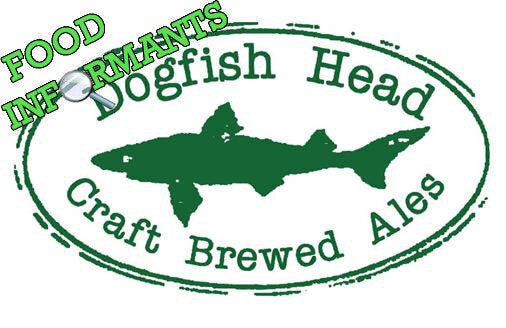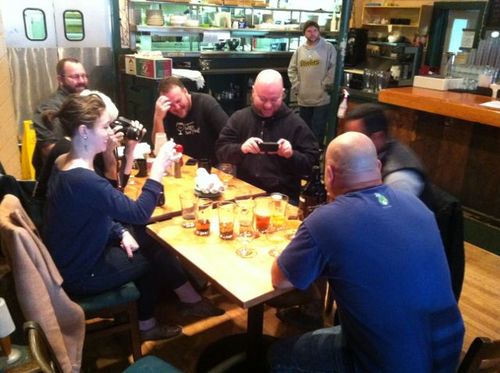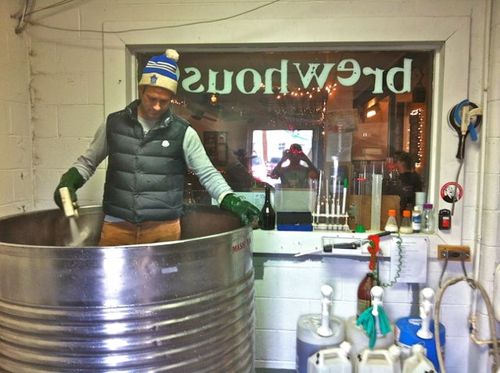
Food Informants is a week-in-the-life series profiling fascinating people in the food world. We hope it will give you a first-hand look at the many different corners of the food industry. Know someone who would make a great Food Informant? Tell us why.
Ben Potts, 28, is the lead brewer at Dogfish Head Brewing & Eats in Rehoboth Beach, De. After Ben discovered craft beer, there was no turning back. His first forays into this world were Sierra Nevada Pale Ale and Bigfoot Barleywine, as well as Dogfish Head's Midas Touch and 90 Minute IPA. Talk about full circle! When a friend started homebrewing, he thought, "Hey, I can do this," and picked up his first kit. His first professional gig came about five years later. He was in art school studying to become a painter, but decided brewing might be a more achievable -- but equally creative -- career, so he dropped out and started volunteering at Dock Street Brewing Co. "I worked my ass off until they hired me as assistant brewer," he says. "Then I took over as head brewer in October 2008."
Ben moved from Philadelphia to Rehoboth this fall to work at Dogfish Head's brewpub. Outside of the brewhouse, he enjoys hiking, camping, mountain biking, roller hockey, movies, fantasy novels, cooking and having a pint with friends and family.
Read Ben's diary below to learn about how he crafts experimental beers for Dogfish Head.
Monday, December 5
9:30am: I arrive at the pub to prepare for the busy week ahead. Most of what I'll be doing is getting ready for our top-secret brew day on Friday with BeerAdvocate founders Jason and Todd Alstrom. Dogfish Head is the primary sponsor of BeerAdvocate's annual Extreme Beer Fest, a festival of the boldest and most exotic brews around. Each year, Dogfish founder Sam Calagione and the Alstrom brothers collaborate on an exciting beer that gets brewed here at the pub. Even though I've only been on the job for a little over the month, I get the pleasure of taking part and coordinating everything for this special brew -- making sure all of the grain and specialty ingredients are ready, prepping the equipment, and finally, brewing the beer with Sam and the Alstrom brothers. Since the beer will have been announced by the time this posts, I can reveal that it's a dirty martini beer inspired by the small-batch gin that's distilled here at the pub. An olive puree will be added to the beer along with the botanicals we use in our Dogfish Head Jin.
9:35am: I run into Alison, the distiller, and we go over our schedules for the week. She uses the brewhouse as well to make wash for our small-batch distillery upstairs, so on busy weeks like this we really have to coordinate both of our schedules.
9:45am: Coffee. The coffee machine was the first piece of equipment I familiarized myself with when I started working here.
9:50am: Head down to the office to go over the week with Jason, the pub's general manager and a fine brewer himself, and review everything needed for the big brew day on Friday. Answer any emails and tie up loose ends for the month of November, including finalizing inventory and making sure all invoices pertaining to the brewery are coded and filed. Not everything a brewer does is glamorous.
10:55am: Office work out of the way, it's time to check on the beer that Sam and I brewed last week, a beer named Positive Contact. It's an imperial Belgian wit brewed with hand-pressed cider, cayenne pepper and cilantro. I check the gravity, or the amount of sugar in the brew. By monitoring the amount of sugars through fermentation I can see how the beer is progressing. I also taste the beer to evaluate the flavors, see how the specialty ingredients play out, and check for any possible off flavors. Tasting good so far!
12:15pm: Preparing to keg off the final test batch of Tweason'ale, a new gluten-free beer we're about to release.
12:45pm: Mmmmm. Braised pork shank, one of the food specials for the day. So delicious.
1:30pm: I get the Tweason'ale kegged off so I can clean and sanitize the Grundy tank, the tank we condition and carbonate our beers in. I'm doing this so I can transfer a finished beer out from one of the two fermenters we have, which will free it up for the brew on Friday. It's a momentous occasion for me, because the beer I'll be transferring is my first beer brewed here at Dogfish Head! Dubbed Low Rider, it's an English-style mild ale.
3:30pm: I get the tank set up to be CIP'ed, or "cleaned in place." This is the process we use for cleaning and sanitizing most of our equipment. The Tweason'ale really gunked up the tank, so it takes a little longer than expected.
6:15pm: The beer is transferred, and it's time to clean up. Everything gets rinsed thoroughly and put away in its proper home. Since Alison will be busy using hoses and equipment in the brewery tomorrow, I'll save the fermenter cleaning for Wednesday.
6:45pm: Time for the after-shift beer! What shall I have? Decisions, decisions. How about Bitches Brew.
Tuesday, December 6
9:15am: Time to clean some draft lines. We love flavorful beers here, but sometimes all of those bold flavors require some extra attention when it comes to cleaning the draft lines. I run cleaner into the line and then stop it to let it get a good soak.
9:30am: It's time to carbonate/nitrogenize the Low Rider ale that I transferred to the holding tank yesterday. This process takes anywhere from 2-4 hours. I set up the first step of the process and get carbon dioxide flowing through the beer. Since this beer is going to be poured through the nitro line, nitrogen will also be dissolved into the beer, but this will come after the small dose of carbon dioxide.
9:45am: While the C02 runs through the beer, I have some time to get down to the office and check all of my emails and do some paperwork. I just recently passed my 30-day mark with company, so it's time to enroll in the insurance plan. Woo-hoo!
10:30am: Time to add nitrogen to Low Rider.
10:40am: The delivery truck arrives from the Dogfish Head production brewery about 10 miles away in Milton. It has a bunch of grain for upcoming brews -- including Friday's -- that gets loaded into the grain shed. I send a sample of the Low Rider back on the truck so the lab can get a precise final ABV and gravity reading. One of the great luxuries not available to many brewpubs is having access to the Milton quality control lab.
12:30pm: I go in to check on the Low Rider. I find beer foaming out of the top pressure-relief valves. It has spilled all over the tank onto the floor. Doh! Time for some cleanup. I turn off the nitrogen and close all of the valves in order to let the beer settle.
1:20pm: Email! There is a lot of back-and-forth as we nail down details of the recipe for our special brew on Friday.
1:50pm: I finish cleaning the tap line that had been soaking and rinse it thoroughly. I taste the water coming out to check and see if any flavor from the previous beer carried over. Tastes fine. I switch the Tweason'ale over to that freshly cleaned line and get ready to tap and test the Low Rider.
2:50pm: Finally the Low Rider is run through the tap. The beer cascades beautifully as it flows from the tap into the pint glass. My first brew is a success! Nice and malty, with a subtle herbal hoppiness and incredibly silky/creamy mouth feel due to the nitrogenization. I couldn't be more excited! A real milestone, my first Dogfish beer!
3:15pm: Check in on Positive Contact. I check the gravity and take a little taste. Everything coming along nicely.
3:25pm: Even more email. Finalizing last-minute tweaks to the recipe for Friday and making sure everything will be ready and all set to go. One less thing to worry about.
5:00pm: Jesse, the brewing supervisor up at the Milton brewery, arrives with a special gift: 6 pounds of olive powder, one of the specialty ingredients that I will prep for Friday's brew.
Wednesday, December 7
10:15am: I get in to the pub and immediately start prepping the olive powder. To do this I get out the propane cooker and a 5-gallon stockpot. First I give the pot a good cleaning and then fill it with 3 gallons of water. I light the burner and start heating up the water. While this is going I run down to the office to check email. Because of the innovative nature of some of our beers, there are often lengthy discussions and prep work that lead right up to the point of action. Sometimes the process changes several times in one day. This is one of those brews, and I go over emails with Tim, the brewmaster at our Milton brewery. Once I get the plan straight with Tim, I run back upstairs and get the tunes cranking. The soundtrack for this part of the day is DJ Shadow's "Miami Bass Mix." Helps get the blood flowing.
12:42pm: After some technical problems with our digital scale, I finally get the olive powder weighed out and added to the boiling water.
1:01pm: The 15-minute boil of the olive solution is done. The heat is turned off and I let the mixture rest for 30-45 minutes before taking it to the beer walk-in cooler to sit overnight.
2:00pm: I get back down to the office to answer more emails. There are always lots of emails.
2:30pm: One of the sales reps stops by with some folks from a couple of the distributors who buy our beer in Maryland, so I give them a tour of the brewery and chat beer for a bit.
3:30pm: I get the fermenter set up for cleaning. There are lots of hoses and valves involved so this can take a while.
5:40pm: One last task for the day: check in on the Positive Contact and take another gravity reading. Still fermenting, slowly but surely.
6:00pm: Of course, you know what comes next -- beer! Bitches Brew had my heart the past two nights, but tonight I think I'll go with My Antonia. This should be a good pregame to get home and watch the Flyers play Buffalo.
Thursday, December 8
9:30am: I get started constructing a vessel that we can use to deliver the olive solution to the brew tomorrow. For all the homebrewers out there, it's basically a racking bucket, but constructed from a clear plastic 5-gallon water jug so that we can monitor the level of the liquid as it drains into the kettle.
11:40am: Today I join the restaurant staff for their pre-shift meeting. I try to do this as often as I can, but some days I just have too many things to do.
12:00pm: Go to the walk-in and retrieve the olive "soup" so I can skim any excess fats/oils from the surface.
12:20pm: Upon skimming the liquid and stirring up the olive mixture, I realize we're going to have to do things a little differently then planned. As I mentioned yesterday, with new ingredients and processes, things can evolve day to day. Sometimes with things like this it really is trial and error. So, I head down to the office to email brewmaster Tim about my thoughts on changing the process for adding the olive mixture to the beer.
1:50pm: At this point I have some time to get the grain together for tomorrow's brew. So I get the mill running and grind the grain (necessary to release the starches in the malted barley, which will be converted to sugars during the brewing process tomorrow).
2:30pm: I head down to the office to check email, get the brew sheet ready for tomorrow, and also to email Marne up in Milton about the past couple of beers we transferred so she can fill out the state and federal tax reports accordingly.
3:30pm: I take the time to prep the fermenter for the brew tomorrow so I don't have to worry about it in the morning. I cleaned the fermenter yesterday, but it now it has to be sanitized.
4:30pm: With the tank sanitized, the grain prepped, and the olive solution skimmed and back in the cooler, I'm all set for tomorrow's brew. I'll leave the spices until tomorrow so that Sam and the BeerAdvocate crew can help prep those.
4:45pm: One more gravity reading on the Positive Contact before I head out.
7:30pm: Catch the beginning of the Flyers vs. Penguins game before heading to the welcoming gathering for the BeerAdvocate folks.
8:30pm: Text from Tim: "Where are you???? We're here hanging out!" I head over to the Henlopen Oyster House to enjoy some beers with everyone. Have to be careful, though - early day tomorrow.
Friday, December 9
6:55am: I get over to the pub and begin setting up for the day's brew. I fill the kettle with water and get the burner fired up to get the water to the proper temperature we need for the first step in the brewing process: mashing in.
7:15am: With the kettle filled with water I have some time to get some stuff ready for the day. Since I took the time yesterday to sanitize the fermenter (which I would usually do during this time) I get a pot of coffee going and move on.
7:45am: I weigh out the hops that we'll need for the brew. For this recipe, we're using whole-leaf Cascade, which is also one of the botanicals used for the Dogfish Jin.
8:00am: I get all of the hoses set up for mashing in. I set up to get hot water from the kettle where I have water heating, and hook the cold water up so I can blend to get the right water temperature for the mash, which is crucial to get the right type of mouth feel and body for the beer.
8:40am: Tim arrives at the pub. We taste some of the Positive Contact. This is the first time he's able to get a taste since Sam and I brewed it the week before. He helped come up with the amounts for some of the ingredients used, so we check to see how they come through.
9:15am: Tim and I move on to finishing up the milling of the grain for the day. Sam arrives at the pub.
9:24am: The Beer Advocate crew arrives. Time to get started!
9:45am: With everyone settled in, we get started mashing in. This is the part of the brew where we mix malted barley together with hot water to convert the starches to sugars, which the yeast will eat later during fermentation to create alcohol and C02.
10:15am: Once we're all mashed in, I juggle hoses and get set up for the next part of the brew process. Once I'm done I join everyone out in the dining area where we taste teas made from all of the different spices we'll be using to see what they'll contribute to the beer. We also taste the test batch for the brew which I made a couple of weeks earlier to get an idea of how the finished beer will taste, and to see if we want to modify any of the spice additions. We all agree the beer needs more of the olive flavor, and that the Juniper berry addition is a little subtle. We adjust the amounts that we'll be adding to the beer to reflect these changes.
10:48am: Now that the mash has rested for enough time I start the vorlauf, which is a German term for basically filtering the wort (the pre-fermented sugary liquid we created) by recirculating through the mash and naturally filtering the liquid using the husks of the barley malt.
11:15am: Once the beer has vorlaufed long enough and the wort has cleared, we begin the sparge where water is added and the wort is transferred to the kettle to be boiled.
11:58am: The transfer finishes and I break apart the set to clean everything up and put everything away. I spill wort all over myself. Making messes is all part of the fun of working in the brewery.
12:30pm: Now that the wort has been transferred out of the mash tun, we need to get the spent grain out and into buckets so the pig farmer who feeds his pigs our grain can come pick it up. The pigs eventually come back to our pub as the bacon in our BLTs. Sam and the rest of BA crew jump in and shovel out the mash tun.
2:10pm: The wort is finally up to boil, so now we can begin with the kettle additions.
2:22pm: We add the Cascade hops, which will lend a touch of bitterness to the final brew. Cascade hops are just one of the several botanicals used in our Jin, which will also be added to this brew.
2:47pm: 25 minutes later we add the Juniper berries and black peppercorns. These are added earlier in the boil than some of the other spice additions to extract more flavor.
3:07pm: 20 minutes later we add the rest of the spices -- Curacao orange peel, lemon peel, angelica root and coriander.
3:22pm: 15 minutes later the boil is finished and we turn off the heat. The total boil time is 60 minutes, which fully dissolves the bittering oils from the hops and drives off certain unwanted flavors from the wort. At this point we add the olive solution. This is added at the very end to retain as much of the flavor and aroma properties of the olives as possible.
4:35pm: With the brew finished and transferred over to the fermenting vessel, it is time for cleanup. What a mess we've made today!
5:45pm: With the brewery looking sparkly clean, it's time to head upstairs and join everyone for the Dogfish/BeerAdvocate happy hour and enjoy some beer and good company.
9:00pm: I meet up with the BeerAdvocate gang for a last round before they head up to Brooklyn early the next morning. All in a day's work!
See previous Food Informants below:





